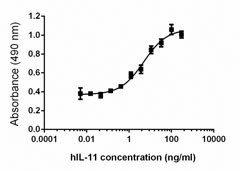- Regulatory Status
- RUO
- Other Names
- Adipogenesis Inhibitory Factor (AGIF)

-

7TD1 cell proliferation induced by human IL-11.
| Cat # | Size | Price | Quantity Check Availability | ||
|---|---|---|---|---|---|
| 585902 | 10 µg | $218.00 | |||
| 585904 | 25 µg | $382.00 | |||
| 585906 | 100 µg | $1050.00 | |||
| 585908 | 500 µg | $3456.00 | |||
IL-11, a member of the IL-6 family of cytokines, exerts a wide range of biological effects on various cell types including hematopoietic cells, hepatocytes, adipocytes, neurons, and osteoblasts. IL-11 works synergistically with other growth factors including SCF, IL-4, IL-3, IL-7, IL-12, IL-13, and GM-CSF to stimulate the proliferation of cells from several hematopoietic lineages. Binding of IL-11 to IL-11 receptor (IL-11R) induces membrane bound gp130 homodimerization and triggers STAT3 phosphorylation by JAK. IL-11 shares the common receptor subunit gp130 with IL-6, IL-27, LIF, OSM, CNTF, CT-1, CLC, and NP. Female mice deficient in IL-11R revealed an important role for IL-11 in embryonic implantation. In addition, IL-11 shows anti-inflammatory activity in models of inflammatory bowel disease, chemotherapy induced oral mucositis, and inflammatory arthritis. IL-11 and IL-13 are highly expressed in asthmatic airways (Th2 response), and IL-11 can inhibit Th1 responses and inhibits the production of Th1 cytokines such as IL-12 and shifts inflammation in Th2 direction. Elevated IL-11 expression is associated with tumor grade and invasion in gastric cancer. Recombinant human IL-11 has been clinically approved to improve platelet recovery after chemotherapy-induced thrombocytopenia.
Product Details
- Source
- Human IL-11, 180 amino acids Val20-Leu199 (Accession# P20809.1) was expressed in 293E.
- Molecular Mass
- The 180 amino acid recombinant protein has a predicted molecular mass of approximately 19.3 kD. The DTT-reduced and non reduced proteins migrate at approximately 19.3 kD by SDS-PAGE. The N-terminal amino acid is Valine.
- Purity
- >98%, as determined by Coomassie stained SDS-PAGE.
- Formulation
- 0.22 µm filtered protein solution is in PBS.
- Endotoxin Level
- Less than 0.01 ng per µg cytokine as determined by the LAL method.
- Concentration
- 10 and 25 µg sizes are bottled at 200 µg/mL. 100 µg size and larger sizes are lot-specific and bottled at the concentration indicated on the vial. To obtain lot-specific concentration and expiration, please enter the lot number in our Certificate of Analysis online tool.
- Storage & Handling
- Unopened vial can be stored between 2°C and 8°C for up to 2 weeks, at -20°C for up to six months, or at -70°C or colder until the expiration date. For maximum results, quick spin vial prior to opening. The protein can be aliquoted and stored at -20°C or colder. Stock solutions can also be prepared at 50 - 100 µg/mL in appropriate sterile buffer, carrier protein such as 0.2 - 1% BSA or HSA can be added when preparing the stock solution. Aliquots can be stored between 2°C and 8°C for up to one week and stored at -20°C or colder for up to 3 months. Avoid repeated freeze/thaw cycles.
- Activity
- The ED50 is 4-12 ng/ml, corresponding to a specific activity 8.3 x 104 - 2.5 x 105 units/mg, as determined by a dose-dependent stimulation of 7TD1 cells proliferation.
- Application
-
Bioassay
- Application Notes
-
BioLegend carrier-free recombinant proteins provided in liquid format are shipped on blue-ice. Our comparison testing data indicates that when handled and stored as recommended, the liquid format has equal or better stability and shelf-life compared to commercially available lyophilized proteins after reconstitution. Our liquid proteins are verified in-house to maintain activity after shipping on blue ice and are backed by our 100% satisfaction guarantee. If you have any concerns, contact us at tech@biolegend.com.
Antigen Details
- Structure
- "four-helix bundle" protein which folds similarly to IL-6.
- Distribution
-
IL-11 can be secreted by various cell types including epithelial, endothelial, keratinocytes, stromal, neuronal, fibroblasts, osteoclasts, and bone marrow stromal cells.
- Function
- IL-11, a multifunctional cytokine, plays important roles in hemopoiesis, thrombopoiesis, megakaryocytopoiesis, and bone resorption; It regulates macrophage differentiation and confers mucosal protection after chemotherapy and radiation therapy.
- Interaction
- Hematopoietic cells, hepatocytes, adipocytes, neurons, osteoblasts, fibroblasts, and gastrointestinal epithelial cells
- Ligand/Receptor
- Membrane bound or soluble IL-11Rα heterodimerize with gp130β.
- Cell Type
- B cells, Hematopoietic stem and progenitors
- Biology Area
- Cell Biology, Cell Motility/Cytoskeleton/Structure, Immunology, Stem Cells
- Molecular Family
- Cytokines/Chemokines
- Antigen References
-
1. Putoczki T and Ernst M. 2010. J. Leukoc. Biol. 88:1109.
2. Wilde MI and Faulds D. 1998. BioDrugs 10:159.
3. Barton VA. 2000. J. Biol. Chem. 275:36197.
4. Robb L, et al. 1998. Nat. Med. 4:303.
5. Lemoli RM, et al. 1995. Br. J. Haematol. 91:319.
6. Elias JA, et al. 1994. J. Biol. Chem. 269:22261.
7. Chen Q, et al. 2005. J. Immunol. 174:2305. - Regulation
- IL-11 expression can also be up-regulated by oncogenic Ras or respiratory virus infections. IL-11 and IL-11Rα are induced by IL-13.
- Gene ID
- 3589 View all products for this Gene ID
- UniProt
- View information about IL-11 on UniProt.org
